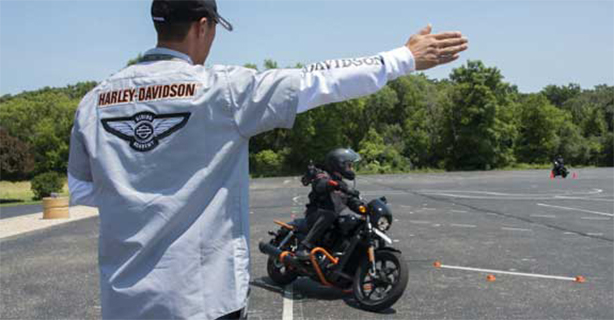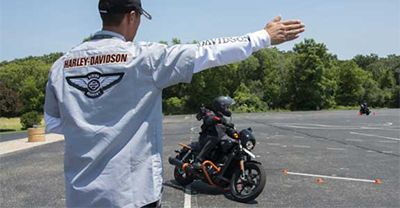Whether it's a cross-country journey on a touring motorcycle or riding a motorcycle through traffic on the highway, we've all seen motorcyclers enjoying their rides. If it looks like fun to you, it probably will be fun for you.
“But can I do it?” The answer is yes!
IS IT HARD TO LEARN HOW TO RIDE A MOTORCYCLE?
Motorcycles are not difficult to ride but you should familiarize yourself with the proper operation of controls and proper riding techniques before starting out.
If you can ride a bicycle, then you can learn to ride a two-wheeled motorcycle, especially if you start by participating in a motorcycle safety course (more on that later).
HOW LONG DOES IT TAKE TO LEARN TO RIDE A MOTORCYCLE?
How long it takes to get comfortable varies from person to person, but if you’re already experienced on a bicycle or dirt motorcycle, you will likely get up to speed quicker. It also varies from motorcycle to motorcycle, however, if you start with a small motorcycle, it will be easier.
WHAT PROTECTIVE GEAR DO I NEED?
When purchasing beginner motorcycle gear, you’ll want the best protective riding gear and for it to cover your body from head to toe. Luckily, motorcycle gear is designed to improve your riding experience by keeping you comfortable in all weather. It also looks cool.
Get A Helmet
A motorcycle helmet is indispensable for riders. Ideally, you'll have your helmet fitted for you by a professional so that you have the best fitting helmet. A full-face helmet provides the most protection, but you’ll need to learn how to clean the motorcycle helmet visor.
Get A Jacket
Your jacket should be made out of either leather or abrasion-resistant textile. Motorcycle gear is different from regular clothing in several ways. Seams are double or tripled to reinforce the stitching and to increase strength. Motorcycle gear is meant to fit tightly so that it doesn't flap around in the wind.
You'll want to try out your motorcycle jacket by sitting in the position that you sit in while riding and, if there’s body armor, be sure to include it in your assessment. Make sure you’re comfortable and that the jacket or body armor is not creating any pressure or pinch points on your body or restricting motion while moving around or operating the motorcycle controls.
Motorcycle Boots And Gloves
Your boots should be sturdy, oil-resistant, with non-slip soles, provide proper ankle support and cover your ankles. Look for boots with strong toe boxes but still allow some tactical feel for the controls, too.
Gloves are also very important because protecting your hands from the elements is key. There are many options available for all riding styles and weather conditions including wind, rain and cold. Look for strong materials and those that cover your whole hand.
WHAT MOTORCYCLE INSURANCE DO I NEED?
The sort of motorcycle insurance you will need can vary from state to state. At a minimum, you'll want liability insurance to provide coverage for the property and well-being of another rider.
You will want collision insurance to cover damage to your motorcycle.
And if you're going on a long trip, you'll want roadside assistance to bail you out of a jam. This can be particularly useful if your motorcycle just needs minor repairs so your whole trip doesn't need to be scrapped.
If you regularly travel more than 100 miles from home, you may also consider Trip Interruption coverage which applies to a motorcycle in the event of a mechanical breakdown or a covered comprehensive or collision loss. This provides reimbursement up to the limits listed in the coverage endorsement for temporary lodging, alternate transportation, meals and deposits on reservations.
WHAT ARE THE BEST BEGINNER MOTORCYCLES?
The Harley-Davidson Street® 500 is an ideal motorcycle to start with once you've completed your first motorcycle safety course. You can use it for daily commuting or weekend excursions. It comes with an anti-lock brake option, which is great for beginners who may over-apply the brakes if panicked.
Another great choice is the Harley-Davidson® Superlow® Motorcycle which is ergonomically designed to take on riding hundreds of miles a day to fend off discomfort. Of course, you can just ride it to the grocery store, too.
Engine Size Less Than 600cc
Most beginners start with a motorcycle that's got a 600cc displacement engine or less. Generally, a motorcycle with a larger displacement engine will be slightly heavier and produce more power or torque to feel more responsive than a smaller displacement counterpart. Beginners typically feel more comfortable on the smaller displacement engines due to their lighter weight and more forgiving throttle responsiveness while honing in their skills, so it’s important to choose a motorcycle that fits your strength and skill level.
Overall, within the range of 600cc is a good place for a first-time motorcycle rider to get a handle on things.
Anti-Lock Braking System (Abs)
As a newer rider, you risk over-applying brakes. For this reason, an anti-lock braking system is a useful option because it will keep your tires and brakes from locking and skidding if you apply the brakes too hard.
Windscreen/Fairing
A windscreen or fairing can be very useful to have on the front of your motorcycle because you can just tuck behind them to protect yourself from wind and weather. Without a windscreen, you may end up getting fatigued from the effort it takes to fight against the force of the wind as you ride. A windscreen may also deflect road grime and insects.
Seat Height
Proper riding ergonomics is paramount. To feel comfortable stopping and standing you're going to need to find a seat height that more or less matches your inseam. Too high of a seat will mean standing on your tippy-toes, while too low of a seat will make it too easy to touch the ground. Figure out your happy medium and you'll feel just right.
Handlebar Height
A handlebar set to the wrong height will just contribute fatigue and discomfort to your ride. Ideally, your elbows should be just slightly bent when you're on your motorcycle to reach the controls. Handlebar height is regulated in many locations. Ensure your motorcycle meets applicable regulations.
HOW DO I MOUNT A MOTORCYCLE?
You'll get the handle of getting on your motorcycle even though it can be awkward the first couple times you do it.
Stand on the left side of your motorcycle.
Bend your knees somewhat and center your weight over your legs.
Take the handlebar grip into your left hand and the right handlebar grip into your right hand and squeeze the front brake lever.
Put your weight on your left leg and then kick your right leg up and over the motorcycle.
Make sure it's a high kick so that your leg doesn't get caught on the motorcycle before your leg completes its journey.
Once you’re on the motorcycle, reacquaint yourself with all the controls. Mind the footpeg position, and where the turn signals, horn, and lights are. Double-check that the mirrors are positioned just how you like them.
WHAT SHOULD I KNOW ABOUT THE MOTORCYCLE CONTROLS?
How do you make your motorcycle stop and go, and what do you do in between? The answer to this question is found in the controls.
The Dash
What's on the dashboard of a motorcycle differs from motorcycle to motorcycle. What you'll always find, though, is a speedometer, which in most countries also has to be lit in the dark so that you can see your speed during the night. Most dashboards will also have a tachometer which displays engine speed in RPM (revolutions per minute). You want to avoid riding in the red zone (it's bad for your engine).
The Mirrors
Mirrors are mandatory on both sides in most countries. They’re your friends, so use them well.
The Turn Signals
Modern motorcycles are required to be equipped with turn signals (those manufactured before 1973 do not have this requirement). Turn signals indicate to everyone around you that you’re turning. The controls are either found on the left handlebar or on most H-D motorcycles there are two controls, one on each handlebar switchpack. They’re meant to be activated using the thumb. Most non-H-D motorcycles don’t self-cancel the turn signals once the turn has been made, so it’s on you to keep things neat.
The Engine Off/Run Switch
The engine cut-off switch, also known as the engine off/run switch, allows you to shut off the engine without removing your hand from the handlebar and is located on the right handlebar of most modern motorcycles. It’s not the only way to turn off your motorcycle, but it can be very useful since you don’t have to look for it to use it. When you’re using your motorcycle, your off switch will be in the run position.
The Starter Button
The starter button is usually located under the engine off/run switch. A lot of start buttons have circular arrows with a lightning bolt in the middle so you can identify them.
WHAT SHOULD I KNOW ABOUT THE THROTTLE AND BRAKES?
The left side of your motorcycle contains the controls to shift gears, while the right side controls focus on acceleration, deceleration, and braking. It may seem like a lot to get used to, but with enough practice, the motorcycle will begin to feel like an extension of yourself, and your graceful movements will lead to enjoyable rides.
The Throttle
The throttle regulates the speed of your ride. On the right end of the handlebar, you'll find the throttle. When you rotate your right wrist toward you (or roll-on the throttle), the amount of gas you give the engine increases. Rotating your wrist away from you (or roll-off the throttle) gives the engine less gas.
You always want to start with your wrist in a flat position. With enough practice, your throttle control will allow you to smoothly accelerate and decelerate your ride, as opposed to a herky-jerky ride.
The Front Brake Lever
On the right side of the handlebar, you'll find the front brake.
The Rear Brake Lever
The rear brake is found on the right side of your motorcycle near your right foot.
WHAT SHOULD I KNOW ABOUT THE CLUTCH?
The clutch is how you change gears. Pulling the clutch in releases the engine from the transmission, which allows you to shift gears. You will also pull in the clutch as you are coming to a stop and slowly release it to begin moving again.
The Clutch Lever
Located on the left handlebar, the hand clutch lever is used to disengage power from the rear wheel as you shift gears.
The Shift Lever
While you're pulling the clutch lever, you'll be using the gear shifter to shift one gear up or down. The gear shifter is located by your left foot.
HOW DO I START MY MOTORCYCLE?
Now that you know where the clutch and gear shift are you can finally start your motorcycle.
Insert the key into the ignition of the motorcycle and, if your motorcycle is not fuel injected, then pull the choke all the way out unless the motorcycle has been running previously, then set as needed. Turn the key in the ignition to the “on” position and make sure the engine off/run switch is set to “run”.
Check to make sure the motorcycle gear shifter is in neutral and squeeze the motorcycle clutch lever with your left hand all the way to the grip.
Press the start button with your right thumb and allow the motor to turn over until the engine fires before releasing the start button. For non-fuel injected motorcycles, gradually push the choke in as the motorcycle engine warms up.
SHOULD I ALLOW THE ENGINE TO WARM UP?
Unlike with cars, you actually need to warm up your motorcycle, So, once started, let your motorcycle warm up for about 45 seconds or longer in cooler weather. Try to avoid revving the engine during warm-up.
WHAT SHOULD I KNOW ABOUT THE SIDESTAND OR CENTER STAND?
These days, some motorcycles are built to automatically turn off if the side stand is down. If your motorcycle doesn't do that, manually retract your side stand using your left foot. Just kick it up so the side stand can fit nearly underneath your motorcycle's underbody.
Center stands, meanwhile, need the motorcycle to be rocked forward. Before attempting to retract the center stand, observe how motorcycles may react coming off the center stand and perform a self-assessment to verify your ability to execute this task. To make this happen, stand to the left of your motorcycle, put your hand on the left handlebar, and straighten out the front tire. With your right foot, check to see that the center stand is on the ground. Next, push the motorcycle gently forward, causing the center stand to click and pop up.
HOW DO I RIDE AND STEER MY MOTORCYCLE?
The engine has been warmed up, you've shifted into first gear, you've let the clutch lever out, and roll-on the throttle at the same time. Now you’re literally moving.
Accelerate a little and put your feet onto the pegs. As you let out the clutch and roll-on the throttle to pick up speed, continue to ride. When you want to take a break, pull in the clutch lever and slowly engage both the front and rear brakes at the same time. Your left foot is used to steady the motorcycle as it stops, and once you've come to a complete stop you can put your right foot on the ground too.
Turning is easier to do than it is to explain, so trust yourself once you're actually riding. The way steering works is that at very low speeds, you use direct steering by turning the handlebars in the direction you want to go. Once you’ve hit between 10-15 mph, you lean slightly in the direction you want to turn while pushing the handgrip on the same side away from you (this is called countersteering). So, if you want to go right you lean right and push the right handgrip away from you.
HOW DO I SHIFT GEARS?
To shift gears, you'll be coordinating the use of the clutch lever on your left hand with the shift lever using your left foot. It takes practice to upshift and downshift through the gears, and in particular to find neutral. You'll know you're in neutral, though, when the green "N" lights up on your dashboard/instrument and you can easily move your motorcycle forward and backward with the clutch lever out.
Pull the clutch lever in, shift gears, and then slowly release the clutch lever. This way, shifting will be a smooth transition. Don't over-rev in each gear, and don't shift before the engine starts to work too hard.
WHAT ARE OTHER GOOD RIDING HABITS?
The best way to have a fun ride is by having a safe ride. That’s because riding safely improves the quality of your ride and makes you feel better riding. First, take the time to read your motorcycle owner’s manual to become familiar with its features and the safe operation, care, maintenance, and storage of your motorcycle. Additionally, follow these safety best practices to get the most out of your trips.
Keep Heels In
If your motorcycle is a sport motorcycle, then you'll see little metal plates shaped like diamonds near the foot pegs. They're heel guards which provide a hard stop to limit foot positioning inboard while riding with your feet on the footpegs to avoid contact with moving suspension components. It’s used as a feeler to gauge how far inboard your heels are pressed in. Doing so can make you feel more confident and in control. If you really want to test this, go a week with your heels in and then ride without your heels in. You'll feel like your feet are just hanging.
Keep Visor Closed
This is worth repeating over and over again: protect your eyes. Harmful UV rays, debris flying into your face, and being affected by the sun's light are all avoided if you wear a visor. If you really need some ventilation, you can raise it an inch.
Assume You’re Invisible
Motorcycles are hard for others to interact with, so just assume no one can see you so that you are riding as safely as possible.
Be proactive in being visible to other road users:
don’t ride in other vehicles blind spots
use lane positioning to increase visibility
wear conspicuous/high vis/reflective gear
scan ahead to search potential hazards and escape paths if needed
OTHER COMMON QUESTIONS:
We’re just scratching the surface of learning how to ride a motorcycle. Here are some things you find out when you dig a little deeper.
Can You Skip Gears On A Motorcycle?
Don't skip gears. Plain and simple.
Are Heavy Motorcycles Hard To Ride?
Heavyweight motorcycles are no different from any other type of motorcycle. But, like riding any motorcycle, a heavyweight motorcycle can be mastered with practice.
Which Foot To Put Down When Stopping A Motorcycle?
Put your left foot down. This way your right foot still has control over the rear brake.
Why Is The First Gear Down On A Motorcycle?
First gear is primarily used for getting your motorcycle from rest to start. You will typically use first gear in situations where there is frequent starts, stops such as heavy traffic or for low speed maneuverability such as pulling into a mall parking space.
Do You Need To Be Strong To Ride A Motorcycle?
No, but your strength does need to match your physical ability to operate the controls of the motorcycle while riding and while at a stop.
BOTTOM LINE ON LEARNING TO RIDE A MOTORCYCLE
You can do it.
There’s so much joy that comes from motorcycling that the effort necessary to learn how to ride is itself joyful. Sure, you may be worried and you may struggle, but since the challenge is part of the reward, you’ll be grateful every step of the way that you chose to pursue your dream.
Related Resources
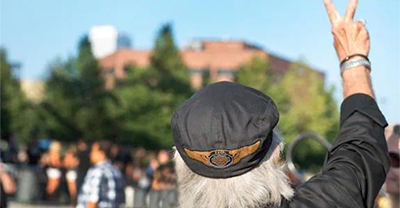
Discover the essential motorcycle hand signals you need to know to communicate effectively with other vehicle operators when riding. Learn more!
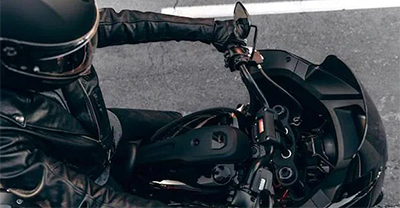
The insurance logistics to test ride a motorcycle can be complicated if there is an unforeseen motorcycle incident. Here’s everything you need to know.
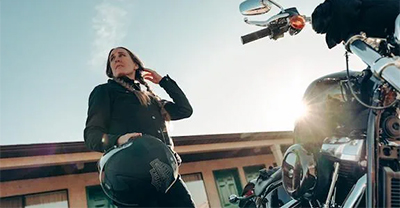
Getting a motorcycle license can differ from state to state. Discover the breakdown of the different requirements to obtain a license in your state.

Choosing the right motorcycle insurance can be a daunting task—it needs to fit your needs and your lifestyle. Here's what you need to know!

